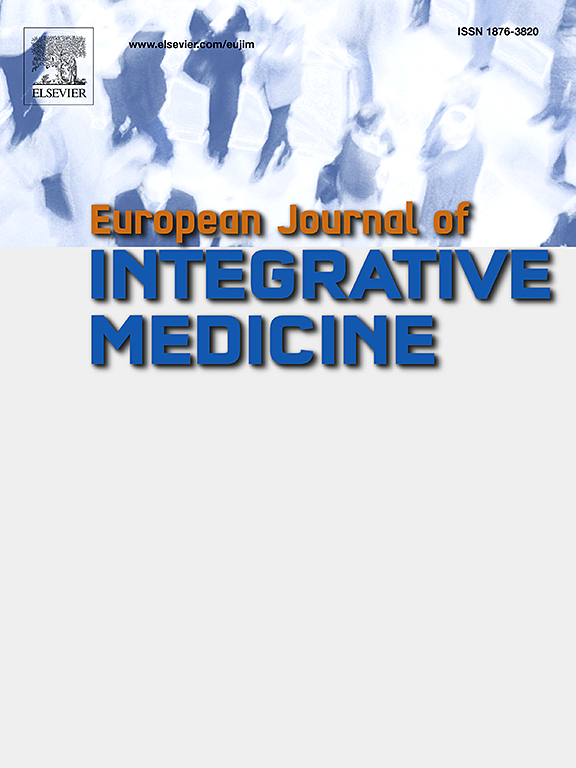Curcumin for the prevention and treatment of cataracts: A systematic review of preclinical studies and potential therapeutic mechanisms
IF 1.7
4区 医学
Q3 INTEGRATIVE & COMPLEMENTARY MEDICINE
引用次数: 0
Abstract
Introduction
Cataract is one of the leading causes of blindness worldwide. Recent research has established that oxidative stress and free radical damage significantly contribute to the development of cataracts. Studies focused on cataract prevention and treatment have investigated curcumin, an antioxidant derived from plants. The present systematic review aims to provide an overview of the current evidence regarding the effectiveness of curcumin in the prevention and treatment of cataracts, as well as the underlying mechanisms of its action, based on preclinical studies. Curcumin (diarylheptanoid) is an antioxidant derived from the rhizome of Curcuma longa.
Methods
Studies indexed in Google Scholar, PubMed, Scopus, and Web of Science were searched for from publication dates until October 10, 2024. The search strategy utilized keywords related to cataracts and curcumin. In vivo, in vitro, and trials published in English that assessed the therapeutic or preventive potential of curcumin against cataracts were eligible for inclusion. Information was gathered on the types of studies, cell types or animal models used, the aims of the studies, interventions, primary outcomes, and whether curcumin could help in preventing the development of cataracts or improving the condition, as well as the reported mechanisms of action. SYRCLE's risk of bias tool was used to identify potential biases in animal research.
Results
Out of 206 papers screened, only 17 papers (nine in vivo studies, seven in vitro studies and one both vivo-in vitro study) met the selection criteria for the current review. All included literature confirmed the anticataract property of curcumin. They showed that the cataract prevention capability of curcumin was related high on the basis of lipid peroxidation inhibition and stimulation of antioxidant enzymes. No human studies were found that investigated the anticataractogenic role of curcumin.
Conclusion
Curcumin has the potential to serve as a therapeutic agent for the prevention and treatment of cataracts due to its antioxidant activity. However, to fully harness the clinical benefits of this compound, issues related to its bioavailability must be addressed. To realize the full potential of curcumin as an effective strategy against cataracts, conducting clinical trials is essential.
姜黄素预防和治疗白内障:临床前研究和潜在治疗机制的系统综述
白内障是全世界致盲的主要原因之一。最近的研究表明,氧化应激和自由基损伤是白内障发生的重要因素。姜黄素是一种从植物中提取的抗氧化剂,研究的重点是白内障的预防和治疗。本系统综述的目的是在临床前研究的基础上,对姜黄素预防和治疗白内障的有效性及其作用机制进行综述。姜黄素(二芳基庚烷)是从姜黄根茎中提取的抗氧化剂。方法检索b谷歌Scholar、PubMed、Scopus和Web of Science收录的论文,检索时间为发表日期至2024年10月10日。搜索策略使用了与白内障和姜黄素相关的关键词。评估姜黄素对白内障的治疗或预防潜力的体内、体外和英文发表的试验均符合纳入标准。收集了有关研究类型、使用的细胞类型或动物模型、研究目的、干预措施、主要结果以及姜黄素是否有助于预防白内障的发展或改善病情,以及已报道的作用机制的信息。使用sycle的偏倚风险工具来识别动物研究中的潜在偏倚。结果在筛选的206篇论文中,只有17篇(9篇体内研究,7篇体外研究和1篇体外研究)符合本综述的选择标准。所有文献均证实了姜黄素的抗白内障作用。结果表明,姜黄素的白内障预防作用与抑制脂质过氧化和刺激抗氧化酶的作用密切相关。目前尚未发现姜黄素的抗心血管疾病作用的人体研究。结论姜黄素具有抗氧化作用,有可能作为预防和治疗白内障的药物。然而,为了充分利用该化合物的临床益处,必须解决与其生物利用度相关的问题。为了充分认识姜黄素作为对抗白内障的有效策略的潜力,进行临床试验是必不可少的。
本文章由计算机程序翻译,如有差异,请以英文原文为准。
求助全文
约1分钟内获得全文
求助全文
来源期刊

European Journal of Integrative Medicine
INTEGRATIVE & COMPLEMENTARY MEDICINE-
CiteScore
4.70
自引率
4.00%
发文量
102
审稿时长
33 days
期刊介绍:
The European Journal of Integrative Medicine (EuJIM) considers manuscripts from a wide range of complementary and integrative health care disciplines, with a particular focus on whole systems approaches, public health, self management and traditional medical systems. The journal strives to connect conventional medicine and evidence based complementary medicine. We encourage submissions reporting research with relevance for integrative clinical practice and interprofessional education.
EuJIM aims to be of interest to both conventional and integrative audiences, including healthcare practitioners, researchers, health care organisations, educationalists, and all those who seek objective and critical information on integrative medicine. To achieve this aim EuJIM provides an innovative international and interdisciplinary platform linking researchers and clinicians.
The journal focuses primarily on original research articles including systematic reviews, randomized controlled trials, other clinical studies, qualitative, observational and epidemiological studies. In addition we welcome short reviews, opinion articles and contributions relating to health services and policy, health economics and psychology.
 求助内容:
求助内容: 应助结果提醒方式:
应助结果提醒方式:


